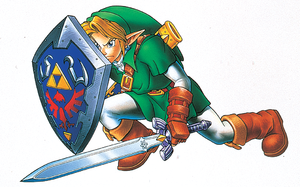| Don't like the ads? Then create an account! Users with accounts have more options than anonymous users. |
Crouch

The crouch is a move that can be performed in various The Legend of Zelda games. It is typically a defensive maneuver.
History[edit]
The Legend of Zelda series[edit]
Zelda II: The Adventure of Link[edit]
In Zelda II: The Adventure of Link, kneeling[1] can be performed if the player presses the D-Pad down while Link is standing. This makes Link stationary, but lowers the Magical Shield down to protect his lower body. This is beneficial to defend against low blows by certain enemies, as well as attack enemies that are too low to reach standing or defending their upper body.
The Legend of Zelda: Ocarina of Time and The Legend of Zelda: Majora's Mask[edit]
In The Legend of Zelda: Ocarina of Time and The Legend of Zelda: Majora's Mask, a crouch can be performed if the player holds the R Button while Link is standing and not targeting. If a shield is equipped, Link automatically holds it and it can be aimed in a forward direction. In Ocarina of Time, there are exceptions to this automatic use of an equipped shield. If Young Link has the Hylian Shield equipped, he will bend down with the Hylian Shield on his back pointed upwards, which is useful against certain obstacles like the falling rocks on Death Mountain. Additionally, if Link draws the Megaton Hammer or Biggoron's Sword, he will not be able to properly defend himself.
In the Nintendo 64 and GameCube versions of Ocarina of Time and the Japanese Nintendo 64 version of Majora's Mask, the crouch is glitched; the damage dealt by a sword stab while crouched is initially the same as the basic Kokiri Sword attack in the former or nullified in the latter if Link has not yet performed a basic melee attack in the area or after transforming, but after performing a basic melee attack, the damage is carried over to the sword stab while crouched, which also includes special properties such as the Megaton Hammer's ability to destroy boulders. This is corrected in later versions.
The Legend of Zelda: The Wind Waker[edit]
In The Legend of Zelda: The Wind Waker, a crouch can be performed if the player holds the R Button while Link is standing without a sword drawn and not targeting. From this position, Link can crawl if the player tilts the Control Stick.
The Legend of Zelda: Twilight Princess[edit]
In The Legend of Zelda: Twilight Princess, a crouch can be performed if the player holds the A Button while Link is sledding on a frozen leaf down Snowpeak Mountain. Once the A Button is released, Link will perform a jump to cross obstacles.
The Legend of Zelda: Breath of the Wild[edit]
In The Legend of Zelda: Breath of the Wild, a crouch can be performed if the player pushes the Control Stick while Link is standing. From this position, Link can walk slowly and quietly if the player tilts the Control Stick, which is a stealth maneuver. Link can still perform certain actions while crouched such as drawing a weapon or aiming an arrow.
Link: The Faces of Evil and Zelda: The Wand of Gamelon[edit]
In Link: The Faces of Evil and Zelda: The Wand of Gamelon, a crouch can be performed the same way as The Adventure of Link by Link and Zelda, respectively. This version of the crouch is mostly used to duck from damage, and has the inclusion of the duck-walk for added mobility.
Super Smash Bros. series[edit]
In the Super Smash Bros. series, a crouch can be performed if the player tilts the Control Stick down (or D-Pad down on Wii Remote only in Super Smash Bros. Brawl) as virtually any character. This can be useful in dodging attacks and, in most games, reducing knockback if timed correctly. Tilting the Control Stick slightly left or right allows some characters to crawl. As of Brawl, the only Zelda character capable of crawling is Sheik.
Trivia[edit]
- Artwork for Zelda II: The Adventure of Link seems to depict Link defending from an Octorok while kneeling. However, in the game, Octoroks perform a short hop before spitting a rock, making kneeling ineffective against it. In addition, the artwork was altered between the Family Computer Disk System and Nintendo Entertainment System releases to depict a blue Octorok instead of a red one.
References[edit]
- ^ Classic NES Series: Zelda II: The Adventure of Link instruction booklet, page 21.
- Zelda II: The Adventure of Link
- Link: The Faces of Evil
- Zelda: The Wand of Gamelon
- The Legend of Zelda: Ocarina of Time
- The Legend of Zelda: Majora's Mask
- The Legend of Zelda: The Wind Waker
- The Legend of Zelda: Twilight Princess
- Super Smash Bros. Brawl
- Super Smash Bros. for Nintendo 3DS
- Super Smash Bros. for Wii U
- The Legend of Zelda: Breath of the Wild
- Super Smash Bros. Ultimate

